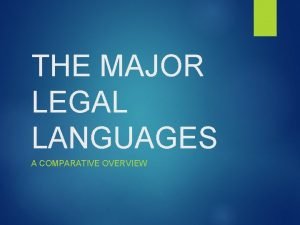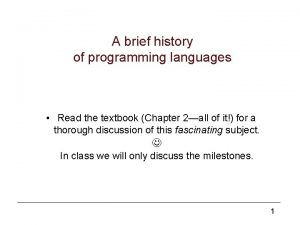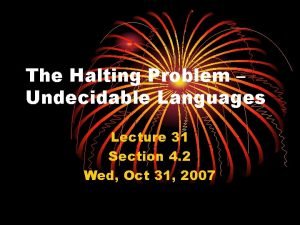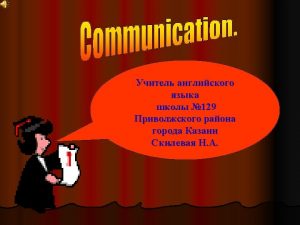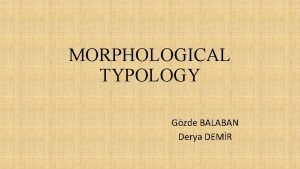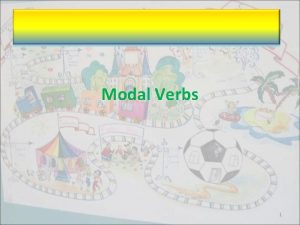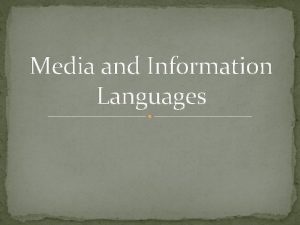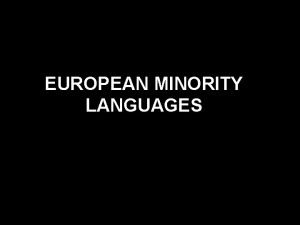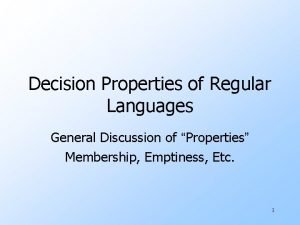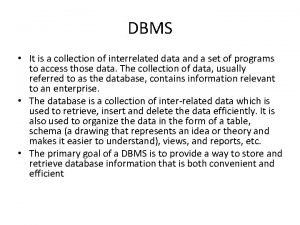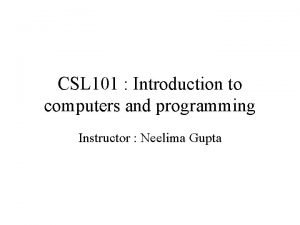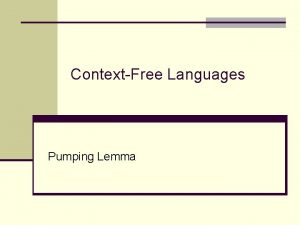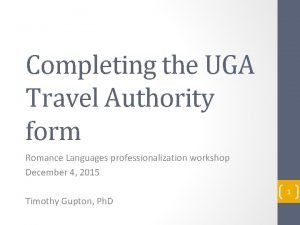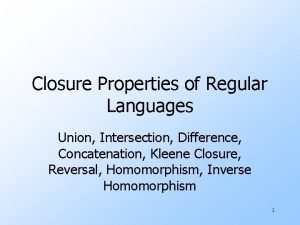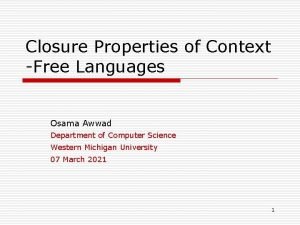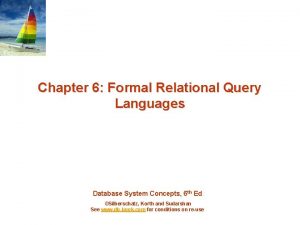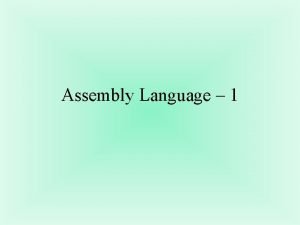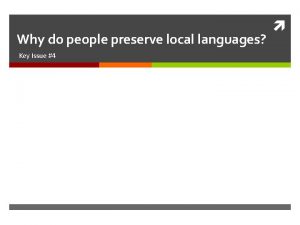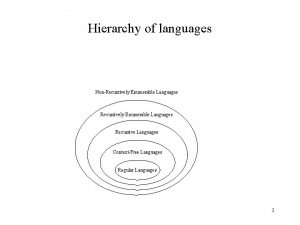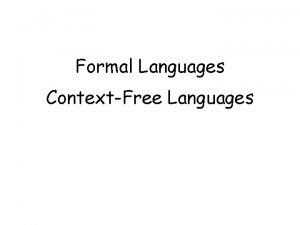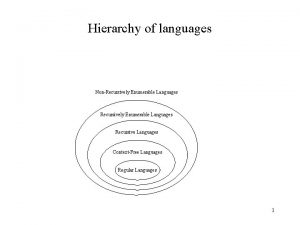Major legal languages Revision History of major legal








































































- Slides: 72

Major legal languages Revision

History of major legal languages • Latin: Old Latin; Classical Latin/Vulgar Latin; Late Latin; Medieval Latin; Renaissance Latin; Modern Latin; Contemporary Latin • German: Old High German (-1050), Middle High German (1050 to 1350; Early New High German (1350– 1650); Standardization • French: Vulgar Latin in Gallia; Old French (8 C-14 C); Middle French (14 c-17 c. ); Modern French • English: Old English (C. 450 - C. 1100); Middle English (C. 1100 C. 1450); Modern English (C. 1450 - )

History of Latin • • Old Latin Classical Latin Vulgar Latin Late Latin Medieval Latin Renaissance Latin Modern Latin Contemporary Latin

Medieval Latin • Without the institutions of the Roman empire that had supported its uniformity, medieval Latin lost its linguistic cohesion • Meanings of many words have been changed and new words have been introduced from the vernacular. • Identifiable individual styles of incorrect classical Latin prevail

Renaissance Latin • By the 15 th century Medieval Latin was replaced by versions supported by the scholars of the rising universities, who attempted to discover what the classical language had been

Modern Latin • During the Early Modern Age, Latin still was the most important language of culture in Europe. • Until the end of the 17 th century most books and almost all diplomatic documents were written in Latin. • Afterwards, most diplomatic documents were written in French and later just native or other languages

Contemporary Latin • The largest organisation that retains Latin in official and quasiofficial contexts is the Catholic Church • • Some states, universities – Latin mottoes Inscriptions on courtrooms, seals Latin – taught at many high schools Latin legal terms and maxims in European legal languages

Classical Roman law • The first 250 years AD are the period during which Roman law and Roman legal science reached its greatest degree of sophistication. The law of this period is often referred to as the classical period of Roman law. • The literary and practical achievements of the jurists of this period gave Roman law its unique shape

Germanic laws (5 th-9 th c. ) Leges barbarorum Customary law: local, fragmented; oral, based on careful memorization When justice is oral, the judicial act is personal and subjective Power, whose origins were at once magical, divine and military, was exercised jointly by the king and his warriors

CANON LAW • Law of the church courts, • Based on Roman law

The Byzantine Empire • In Western Europe, Roman law as a coherent legal system disappeared with the fall of the Western Roman Empire in 476 • Maintained at a very high level in the Byzantine Empire

Corpus Iuris Civilis (Codex Justinianus, 529 -35 AD) • Most comprehensive code of Roman law, compiled under Justinian I, by a commission of jurists

Ius comune • The rediscovered Roman law dominated legal practice in most European countries. • A legal system, in which Roman law was mixed with elements of canon law and of Germanic custom

NATIONAL CODIFICATIONS • The practical application of ius comune came to an end when national codifications were made • In 1804, the French civil code came into force • In the 19 th century, many European states adopted the French model or drafted their own codes

Rise of national languages • Strenghtening of nation states - the rise of the national languages as symbols of national identity and a tool of power politics

Legal German History and development

Kingdom of the Franks • It is the predecessor of the modern states of France and Germany. • Francia was among the last surviving Germanic kingdoms from the Migration Period era before its partition in 843. • After the Treaty of Verdun in 843, West Francia became the predecessor of France, and East Francia became that of Germany

Carolingian Empire • The language of official acts in the empire was Latin. • The empire was referred to variously as universum regnum ("the universal kingdom", as opposed to the regional kingdoms), Romanorum sive Francorum imperium („Empire of the Romans and Franks"), Romanum imperium ("Roman empire") or even imperium christianum ("Christian empire„)

Fragmentation of the Carolingian empire • The Carolingian dynasty reached its peak in 800 with the crowning of Charlemagne as the first Emperor of Romans in the West in over three centuries. • His death in 814 began an extended period of fragmentation of the Carolingian empire and decline that would eventually lead to the development of the Kingdom of France and the Holy Roman Empire.

The Roman Catholic Church as a unifying force • With the disintegration of the Frankish kingdom in the late 9 th century, government became highly decentralized • the Roman Catholic Church became the main unifying force in western Europe and began to claim jurisdiction over many matters that earlier had been considered secular rather than ecclesiastical. • The canon law was largely influenced by Roman law and contained very few Germanic elements.

The Holy Roman Empire • The Holy Roman Empire became eventually composed of four kingdoms. The kingdoms were: • Kingdom of Germany (part of the empire since 962), • Kingdom of Italy (from 962 until 1648), • Kingdom of Bohemia (since 1002 as the Duchy of Bohemia and raised to a kingdom in 1198), • Kingdom of Burgundy (from 1032 to 1378).

Holy Roman Empire • Over time, the Empire grew increasingly powerless in relation to the regional power centres • Power of the emperor diminished, that of regional princes flourished • Formally, the Empire lasted until 1806

Official languages • Official languages for the Holy Roman Empire for the whole of its existence: German and Latin

History of the German language • • Old High German (-1050) Middle High German (1050 to 1350) Early New High German (1350– 1650) Standardization

Old High German • the surviving texts of OHG show a wide range of dialectal diversity with very little written uniform

Middle High German (1050 to 1350) • Along with the increasing wealth and geographic extent of the Germanic groups came greater use of German in the courts of nobles as the language of official proceedings and literature – emergence of a standardized supra-dialectal written language • While these efforts were still regionally bound, German began to be used in place of Latin for certain official purposes, leading to a greater need for regularity in written conventions

Early New High German (1350– 1650) • As a spoken language German remained highly fractured: a vast number of often mutually-incomprehensible regional dialects spoken throughout the German states; • the invention of the printing press c. 1440 and the publication of Luther's vernacular translation of the Bible in 1534 - an immense effect on standardizing German as a supra-dialectal written language.

Standardization (19 th c. ) • The most comprehensive guide to the vocabulary of the German language – Deutsches Worterbuch - created by the Brothers Grimm; composed of 16 parts which were issued between 1852 and 1860. • In 1872, grammatical and orthographic rules first appeared in the Duden Handbuch • In 1901, the 2 nd Orthographical Conference ended with a complete standardization of the German language in its written form and the Duden Handbuch was declared its standard definition.

Leges barbarorum • Several Latin law codes of the Germanic peoples written in the Early Middle Ages after the Fall of the Western Roman Empire (also known as leges barbarorum "laws of the barbarians") survive, dating to between the 5 th and 9 th centuries. • They are influenced by Roman law, canon law, and earlier tribal customs. • Central and West European Germanic law differed from North Germanic law (Scandivanian law)

Early Germanic law • For all of the Germanic peoples, law (West German, reht and êwa; High German, wizzôd; North German, lagh, from which the English word law is derived) was basically not something laid down by a central authority, such as the king, but rather the custom of a particular tribe

Germanic law: Leges Barbarorum • Customary law – oral • The first written collections of Germanic law: Leges Barbarorum (5 th - 9 th century) written in Latin; technical terms of Roman law • Leges Barbarorum- not legislation in the modern sense but rather records of customs that were first collected and then declared as law.

Demise of customary law • Merchants found that the old Germanic customary law was inadequate to cope with the problems created by the rapid growth of commerce that had occurred by the 12 th century. • A special commercial law, based mainly on Roman law as developed by the Mediterranean seaborne traders, was developed to settle disputes between merchants, without regard to their nationality or place of residence.

Reception of Roman law • European universities taught Roman law • ius commune created by medieval lawyers • Roman law was used to stress the status of the Holy Roman Empire as a continuation of the original Roman Empire

Reception of Roman law • As the application of Roman law spread in the German justice system, judges began asking legal scholars for opinions • Case files - sent to universities • German law faculties provided a kind of higher court service esp. in 16 th and 17 th centuries

The Renaissance • With the arrival of the Renaissance, Roman law again began to play a strong role, and later on legal scholars revived the formalities of Roman law as set by Justinian in the Corpus iuris civilis. • It became common law (Gemeines Recht) in large parts of the German-speaking world and prevailed far into the 19 th century. .

The first codes • Prussia made an effort to bring in an all-new set of laws with the Allgemeines Landrecht für die preußischen Staaten (General National Law for the Prussian States) (1794) a system of codification, containing laws in relation to the whole spectrum of legal divisions - had a great influence on later works.

French influence • After the French July Revolution of 1830, revolutionary ideas of the French Revolution and Napoleon's laws such as the Code civil, the Code pénal and the Code d'instruction criminelle strongly influenced the German legal tradition, especially in the Grand Duchy of Baden, which sometimes only translated codifications of France for its own use.

Unification of Germany (1871) • With the forming of the Deutsches Reich in 1871, a major process of legal standardization ensued, beginning with criminal law and procedural law and culminating in the Bürgerliches Gesetzbuch (Book of Civil Law) after over twenty years of creative process. • Important parts of German legislation still contain regulations of these laws. • However, the various states always maintained their own laws to an extent, and still do so in modern federal Germany.

Bürgerliches Gesetzbuch, BGB, 1900 • The most celebrated piece of German legislation • Excellent internal logic of the codes (on the model of natural sciences) but its content is not easily understood from the reader’s standpoint • A monument of refined legal scholarship; written for judges versed in law, not for laymen

The Weimar Constitution • In 1919 in Weimar the Weimarer Verfassung (Weimar Constitution) was created: the first democratic constitution of Germany. • A very liberal and democratic constitution, but it did not include any basic ethical or political principles. • It allowed unlimited changes, the only requirement of any legal decision was a formally correct decision of the appropriate legal institution.

Legal French History and development

History • • • Vulgar Latin in Gallia Old French (8 C-14 C) Middle French (https: //www. youtube. com/watch? v=rp 8 tu 8 Tgr. Xo) Modern French

Vulgar Latin in Gallia • Due to Roman rule, Latin was gradually adopted by the inhabitants of Gaul, and as the language was learned by the common people it developed a distinct local character, with grammatical differences from Latin as spoken elsewhere, some of which being attested on graffiti. • This local variety evolved into the Gallo-Romance languages, which include French and its closest relatives

Old French (8 C -14 C) • The beginning of French in Gaul was greatly influenced by Germanic invasions into the country. • These invasions had the greatest impact on the northern part of the country and on the language there. • A language divide began to grow across the country. The population in the north spoke langue d'oïl while the population in the south spoke langue d'oc. •

Middle French • Within Old French the Francien dialect is one that not only continued but also thrived during the Middle French period (14 th century– 17 th century). • Modern French grew out of this Francien dialect. • Grammatically, noun declensions were lost and there began to be standardized rules. • Robert Estienne published the first Latin-French dictionary, which included information about phonetics, etymology, and grammar. • Politically, the Ordinance of Villers-Cotterêts (1539) proclaimed French the language of law.

Modern French • During the 17 th century, French replaced Latin as the most important language of diplomacy and international relations (lingua franca). • It retained this role until approximately the middle of the 20 th century, when it was replaced by English as the United States became the dominant global power following the Second World War. • Stanley Meisler of the Los Angeles Times said that the fact that the Treaty of Versailles was written in English as well as French was the "first diplomatic blow" against the language

Modern French • During the Grand Siècle (17 th century), France, under the rule of powerful leaders enjoyed a period of prosperity and prominence among European nations. • Richelieu established the Académie française to protect the French language. • By the early 1800 s, Parisian French had become the primary language of the aristocracy in France

Modern French • Near the beginning of the 19 th century, the French government began to pursue policies with the end goal of eradicating the many minority and regional languages (patois) spoken in France. • This began in 1794 with Henri Grégoire's "Report on the necessity and means to annihilate the patois and to universalise the use of the French language". .

Roman law • Rome and its empire collapsed in the 5 th century, but Roman law survived in Gaul at various levels and in different forms.

Germanic custom • In the north and west (the regions where Frankish and Burgundian monarchs had set the stage for legal development), it was only natural that the droit coutumier, based on Germanic custom and tradition, would prevail

Jus commune • The great diversity of French law presented a challenge to the absolutist tendencies of French governments which constantly aspired to centralization of power and unity of laws. • Canon law was a normal vehicle for the unification process, bringing order and consistency to private civil and commercial law, and by the 16 th century, Romano-canonic law had begun to emerge as a potential jus commune for France with principles of natural law.

Napoleon’s Code • intellectually the most significant and historically the most fertile of the codes that came into force in western and central Europe in the first years of the 19 th century.

History of Legal French: Beginnings • Legal and administrative language of Paris began to challenge Latin earlier than any other language • The government and the courts played an important role in the development of French; much of their vocabulary transmitted to ordinary language • French orthography also goes back to the practices of administrative and judicial organs

Discarding Regional Languages • Decree of Lyon (1510) still refers to langue de pays • Decree of Viller-Cotterêt (1539) introduces French explicitly • Judgements and other legal documents had to be drawn up in French, old languages of provinces excluded; protests in non. French speaking regions • At the time of the Revolution, 25 million inhabitants: 6 million did not understand French, 6 million understood it at the basic level, 10 million had a passable knowledge of French

Discarding Regional Languages • Revolutionary decrees obliged civil servants to use French and draw up all public documents in it • French – the language of the army • Compulsory military service, the press, postal services and railways increased the movement of the population and consolidated the central administration

Origins of legal terms • Latin terms transmitted from Antiquity by continuous tradition (loi<lex, juge <judex, justice < iustitia, délit < delictum, société<societas) • Medieval Latin: contumace < contumax ‘contempt’, ‘nonappearance in court’ • Greek: démocratie, politique • Neologisms which were never used in Latin or Greek: autogestion, monoparental; today, legal neologisms of Graeco-Latin origin often come from English

Improving the quality of legal language • Association pour le bon usage du français dans l’administration, Commission de modernisation du langage judiciaire, Centre d’enregistrement et de révision des formulaires administratifs • • • Terms felt to be discriminatory – replaced Courts should eliminate useless repetitions Latin maxims should be reduced Clarity of legal language Today: struggle against Anglicisms

Legal English History and development

HISTORY OF THE ENGLISH LANGUAGE • OLD ENGLISH (c. 450 - c. 1100) • MIDDLE ENGLISH (c. 1100 - c. 1450) • MODERN ENGLISH (c. 1450 - )

LATER OLD ENGLISH (c. 850 - c. 1100) Language Contacts OLD NORSE Lexical words Nouns: birth, bull, dirt, egg, fellow, husband, leg, sister, skin, sky, skirt, window Adjectives: ill, low, odd, rotten, sly, weak Verbs: call, crawl, die, get, give, lift, raise, scream, take, Function words Pronouns: they (their, them) Conjunctions: though Determiners: some, any Auxiliaries: are Names Family names: -son: Johnson, Stevenson Place names: -by 'farm, town': Derby, Rugby, Whitby; -thorp 'village': Althorp, Linthorp

Anglo-Saxon Period: customary law • Verbal magic • Acts of transfer required complicated and precise language rituals; a single mistake could nullify the act • Use of rhythmic expressions, alliteration, binary expressions

Birth of Common Law • After the Norman conquest (1066) • To consolidate his dominance, the king sought to centralise the justice system by establishing the Royal Courts of Justice at Westminster • Royal Courts adjudicated cases within the king’s competence • Progressively, increasing categories of cases transferred to these Courts

Birth of Common Law • Court judgments - importance that went beyond the particular cases in which they had been pronounced • To specify the conditions and limits of the binding effect of judgments, a refined rule of precedent was progressively created • The legal system built by case law strengthened the position of judges

Dominance of Law Latin • The Norman Conquest brought to England a French-speaking upper class • Latin – dominant in law • 11 -12 c. Latin was the language of legal documents in England

Dominance of Law Latin • In this period – common law was created • Many essential common law terms were originally formulated in Latin (e. g. breve ‘writ’) • Meaning diverged from that of classical Latin

Rise of Law French • 1 st law promulgated in French in 1275 • End of 13 th c. both Latin and French used as legislative languages • Early 14 th c. French used in drafting laws (except in Church matters) • Late 13 th c. the Royal Courts used French during sessions; case reports – prepared in French • French became the legal language in England from the late 13 th c. , both for legislation and the law courts

Decline of Law Latin and Law French • 1362 Statute of Pleading “All lawsuits shall be conducted in English, because French is much unknown in the said realm” – drafted in French! – • According to Sir Edward Coke, it was better that the unlearned were not able to read legal materials because they would get it all wrong and harm themselves! • French and Latin finally abolished in 1731

Leal language: synonyms Binary expressions: words with the same meaning existed at the same time in the form of Latin-French variants and Anglo-Saxon variants. Repetitions ensured that legal messages were understandable in a multilingual society Acknowledge and confess, act and deed, devise and bequeath, fit and proper, goods and chattels, will and testament null and void and of no effect, authorized, empowered and entitled to To tell the truth, the whole truth, and nothing but the truth

Legal English in the United States • The influence of English law – terminated with the independence • Nevertheless, the approach to the legal order, fundamental principles and concepts of law, essential legal terminology - the same in England the US

American legal culture • • Fundamental ideas in line with the English tradition 1) supremacy of the law (rule of law) 2) rule of precedent 3) adversarial procedure

American legal tradition • Separation of powers: the system of checks and balances • federalism

History of English • https: //www. youtube. com/watch? v=Sf. Khl. JIAhew
 Active and passive vocabulary
Active and passive vocabulary Legal languages
Legal languages History of computer languages
History of computer languages History of markup language
History of markup language Brief history of programming languages
Brief history of programming languages How useful is this source
How useful is this source Also history physical
Also history physical Why do languages vary among places
Why do languages vary among places What is assembler
What is assembler Multithreaded programming language
Multithreaded programming language Turing unrecognizable languages
Turing unrecognizable languages Love language test
Love language test Love language test results
Love language test results Love language test
Love language test Love langauge meaning
Love langauge meaning 11 official languages of south africa
11 official languages of south africa How many languages are there
How many languages are there What is ruby
What is ruby What languages come from latin
What languages come from latin Relational query languages in dbms
Relational query languages in dbms Real-time systems and programming languages
Real-time systems and programming languages Introduction to scripting languages
Introduction to scripting languages Cs 421 uiuc
Cs 421 uiuc Multithreading program in java
Multithreading program in java Pumping lemma non regular languages examples
Pumping lemma non regular languages examples Languages
Languages New zealand national sport
New zealand national sport Gözde balaban
Gözde balaban Languages for life and work
Languages for life and work Carol can speak three foreign languages
Carol can speak three foreign languages What is media and information languages
What is media and information languages Love language list
Love language list Low level languages
Low level languages Asian languages written
Asian languages written Five love languages.com
Five love languages.com Programming languages levels
Programming languages levels Introduction to programming languages
Introduction to programming languages Polysynthetic language
Polysynthetic language Decidable languages
Decidable languages Front end phases of compiler
Front end phases of compiler Plc
Plc Minority languages definition
Minority languages definition Latin and romance languages
Latin and romance languages Etymology euphemism
Etymology euphemism Adf school of languages
Adf school of languages Defence centre for languages and culture
Defence centre for languages and culture Decision properties of regular languages
Decision properties of regular languages Decision properties of regular languages
Decision properties of regular languages It is a collection of interrelated data
It is a collection of interrelated data Dbms languages
Dbms languages Database languages
Database languages Difference between strongly and weakly typed languages
Difference between strongly and weakly typed languages Category 1 languages
Category 1 languages Pumping lemma for cfls
Pumping lemma for cfls Uga travel authority
Uga travel authority How many different sign languages are there
How many different sign languages are there Is slavic indo european
Is slavic indo european Joey paquet
Joey paquet Imperative programming languages
Imperative programming languages Closure under union
Closure under union Cfl closure properties
Cfl closure properties Alternative programming languages
Alternative programming languages Formal relational query languages
Formal relational query languages Sql languages in dbms
Sql languages in dbms Data mining primitives languages and system architecture
Data mining primitives languages and system architecture Northern ireland official languages
Northern ireland official languages Language
Language Aotearoa the land of the long white cloud
Aotearoa the land of the long white cloud Computer animation languages
Computer animation languages Balto slavic languages
Balto slavic languages Languages in india
Languages in india Languages
Languages Types of programming languages
Types of programming languages

